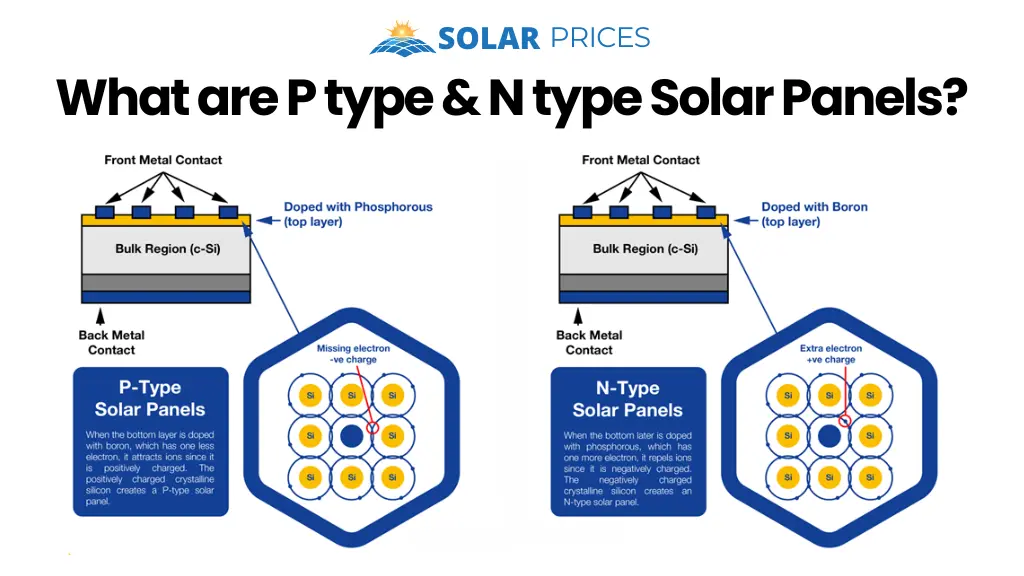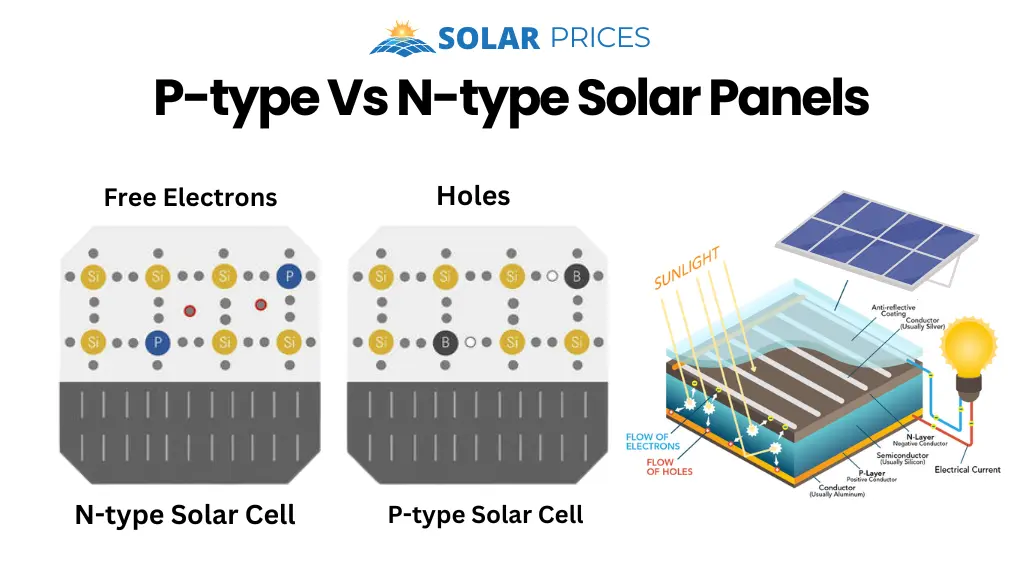What are P-type and N-type Solar Panels? [An Overview]

We are living in the age of ever-evolving technologies (simply speaking solar cell technologies). Solar energy has emerged as a worldwide giant (main player) in the field of energy production. It is also gaining popularity as a tool to reduce electricity bills.
Solar energy is leading homeowners as well as businesses to a self-sustainable energy resource. If you first start exploring solar energy systems, you will encounter two famous types of solar panels available in the market.
These types include p-type solar panels and n-type solar panels. Learning the major differences between them will help you decide on the best solar panel that suits your specific energy needs and investment (budget).
So, what are p-type and n-type solar panels? How these types are shifting the world towards photovoltaic technology and what is their role in transforming sunlight into electricity? Let’s learn solar cells first.
Check out if you want to know today’s solar panel prices in Pakistan.
Which Material is Used in the Manufacturing of a Solar Cell?
A solar cell is the backbone of a solar panel. Standard cell orientations for typical solar panels are 72, 90 120, or 144 cells per panel. Silicon, a semiconductor that makes crystalline solar cells, is used in more than 95% of solar cell production in the whole world today. It is the key element (material ) in solar panel manufacturing due to its excellent electrical properties.
When two different layers of silicon wafers are placed together, there becomes a P-N junction between them. These layers create charge carriers that ultimately constitute electric current to flow through the solar cell.
Types of Solar Panels [P-type Vs N-type Solar Panels]

To develop photovoltaic cells (PV cells), extrinsic silicon material is used. So, the manufacturing of a solar cell varies slightly depending on the materials used. Therefore, based on the doping materials, there are two primary types of solar panels. However, silicon is considered a cornerstone in both these types.
The major difference between p-type and n-type solar panels is what type of crystalline silicon (c-Si) wafers make up the thinner emitter region and which one makes the bulk region inside the solar cell. These silicon wafers function (work) together to produce an electric field inside the solar cell. This field is necessary to generate electrical energy.
What are P-type Solar Panels?
For the manufacturing of P-type solar panels, extrinsic layers of silicon wafers are made by doping trivalent impurity atoms (Boron) to the pure silicon atoms. Here trivalent means having 3 electrons in the outermost shell. Since silicon carries 4 electrons in the outermost shell, so, P-type solar cells are one electron deficient than silicon atoms.
So, P-type solar panels have a positively charged c-si region in bulk quantity. The top emitter layer, in this case, contains holes because of being doped with phosphorus.
P-type solar panels are more popular than n-type in the current solar industry. This is the fact that p-type solar cells stand up better to radiation, widely used in space solar applications, and that’s why have gone through more research than n-type solar panels.
What are N-type Solar Panels?
For the manufacturing of N-type solar panels, extrinsic layers of silicon wafers are made by doping pentavalent impurity atoms (Phosphorus) to the pure silicon. Pentavalen means having 5 electrons in the valance shell. Since silicon carries 4 electrons in the outermost shell, an n-type solar cell (being doped with phosphorus) carries one more electron than silicon.
So, in n-type solar panels, the prominent bulk portion (c-si region) bears a negative charge. This means the top emitter layer of n-type solar cells contains access-free electrons.
N-type solar panels are becoming the central focus of the solar industry because they are less susceptible to light-induced degradation (LID) when compared to P-type solar panels. The N-type panels can serve all types of solar installation projects and have a longer lifespan. However, one minus point of N-type cell technology panels is their high cost over traditional P-type panels.
P-type Vs. N-type Solar Panels
Both types of solar panels namely N-type and P-type are getting more and more attention from homeowners as well as businesses nationwide. It’s critical to understand the key differences in their durability, performance, working environment, cost-effectiveness, and efficiency to opt for the perfect type of panel for your solar system.
If talk about performance and efficiency, the N-type solar panels have a slight edge over p-type solar panels. N-type panels have an extra conversion efficiency of 2-3% than the P-type panels. The major problem (defect) with the p-type solar cell-based panels is their light-induced degradation efficiency loss.
What is the reason behind light-induced degradation? The P-type panels consist of P-type solar cells. These cells are doped with boron, its direct exposure and interaction with oxygen in the air cause a decrease in a panel’s performance. This performance loss may reach up to 10% with time.
It’s pretty obvious that p-type panels dominate the industry but this has a historical background. P-type solar panels were manufactured for space-related energy usage where there is very little to no oxygen.
This initially was going very smoothly with p-type solar panels when employed to energies spacecraft or satellites but the problem occurred when using these panels for solar projects on the Earth.
If we consider lifespan, n-type solar panels last longer than p-type panels. However, when it comes to cumulative installation, p-type panels barely dominate n-type panels.
Pros and Cons of P-type and N-type Solar Panels
It is highly recommended to explore and discover the types of solar panels for good ROI and better solar performance. In the following section, there is a comparison of the pros and cons of both types of solar panels. Let’s learn.
Pros of N-type Panels
- Not susceptible to LID(light-induced degradation)
- Have a long lifespan
- Higher light conversion efficiency
Cons of N-type Panels
- Costly
- Rare in distant cities or limited supply
Pros of P-type Panels
- Affordable
- Easily available in the market
- High resistance to radiation
Cons of P-type Panels
- Light-induced degradation
- Lesser lifespan than N-type panels
Which Solar Panel is the Best for You?
For going solar to reduce financial burden or to save money on heavy electricity bills, you first need to you need to determine whether P-type or N-type panels are the right choice for your solar system. When considering a comparison between P-type and N-type panels (P-type vs N-type panels), you should consider factors such as your energy needs, available installation space for solar plates, and most importantly your budget.
Talking simply, P-type solar panels have a lower upfront cost than N-type panels. However, the N-type solar panels can yield higher solar power (more watts) due to their higher efficiency level.
If there is limited space available to install solar panels, going with the N-type panels is better to fulfill high energy needs. However, if there is a lot of available space for installation going with the P-type solar panels is a better decision. These panels are slightly less efficient but offer higher affordability for homeowners compared to the N-type solar panels.
Conclusion
When you decide to invest in solar energy, you go through the process of market and product research. It’s important to make a better-informed decision. Solar panels are of two types; the N-type and the P-type solar panels. These panels are classified based on doping to the pure semiconductor material. Doping is the key difference between P-type and N-type solar cells. N-type solar panels consist of n-type cells and p-type solar panels consist of p-type solar cells.
P-type refers to the holes or positive charge carriers within the solar cell. N-type refers to the negative charge carriers or free electrons within the solar cell. Both N-type and P-type solar panels are specialized for converting sunlight into electricity. However, N-type panels have a little more efficiency and a longer lifespan than P-type solar panels.
